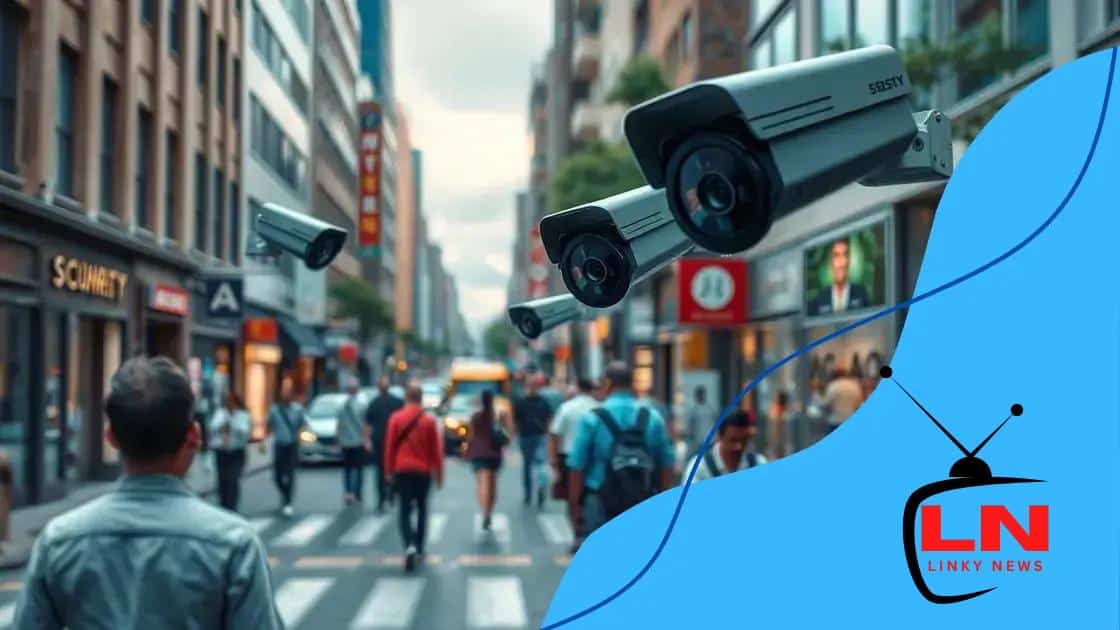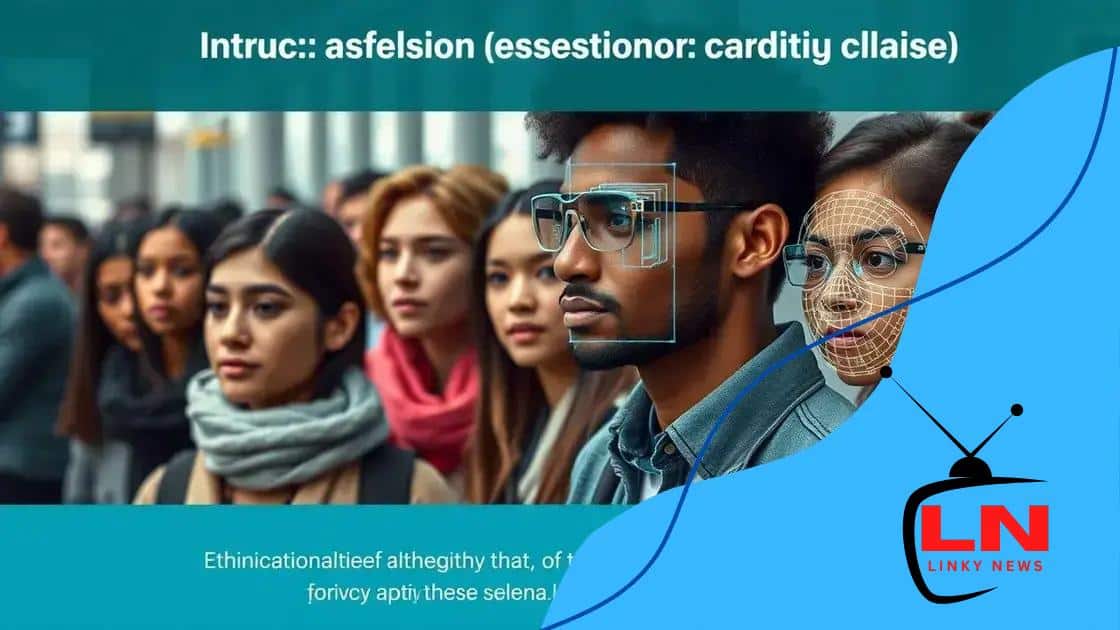The role of facial recognition in enhancing public safety

The role of facial recognition in enhancing public safety involves improving security measures, enabling quicker emergency responses, and identifying potential threats in real-time across various environments like airports and urban areas.
The role of facial recognition in enhancing public safety is becoming increasingly significant as cities worldwide adopt this technology. But how does it really work and what does it mean for our safety? Let’s dive into the details.
Understanding facial recognition technology
Understanding facial recognition technology is essential in today’s world, especially as it becomes more prevalent in our daily lives. This technology uses advanced algorithms to identify and verify individuals based on their facial features. As cities and organizations increasingly adopt these systems, grasping their functioning and implications is crucial.
How does it work?
The technology operates by analyzing specific points on the face, like the distance between the eyes or the shape of the jaw. These unique facial patterns are then compared to a database of known faces.
Key components of facial recognition:
- Image capture: High-resolution cameras capture images of individuals in real-time.
- Feature extraction: The system identifies and records key facial features.
- Matching process: The captured image is compared with stored images to find a match.
As technology advances, so does the accuracy of these systems. Initially, facial recognition technology was limited and prone to errors. However, improvements in artificial intelligence and machine learning have significantly enhanced its capabilities. Now, facial recognition can operate efficiently in various lighting conditions and angles, making it a powerful tool for security.
Despite the benefits, concerns about privacy and misuse of this technology are on the rise. Many people fear that surveillance could lead to a loss of anonymity in public spaces. Navigating these challenges is crucial as we integrate facial recognition into our communities and law enforcement practices.
Overall, understanding how facial recognition works and its implications helps us appreciate its role in enhancing safety while also considering the ethical dimensions involved.
How it improves emergency response
How it improves emergency response is a crucial aspect of facial recognition technology. This system can significantly enhance the ability of first responders to react swiftly and effectively during emergencies. By quickly identifying individuals in distress or those who pose a threat, these systems aid in saving lives.
During critical situations, every second counts. Facial recognition technology can provide immediate identification of missing persons or potential criminals. This capability is particularly valuable in crowded places like airports and stadiums. In these environments, time-sensitive decisions must be made rapidly.
Benefits in emergency situations:
- Rapid identification: First responders can quickly distinguish between individuals, allowing for swift action.
- Real-time surveillance: Continuous monitoring aids in detecting unusual behavior that may indicate a threat.
- Collaboration with law enforcement: Enhanced communication and coordination between agencies improve overall response strategies.
When emergencies occur, having data at their fingertips allows responders to make informed decisions. For example, law enforcement can access facial recognition systems to provide real-time information about suspects during a crisis. This capability enhances situational awareness and enables officers to respond appropriately.
Moreover, the integration of facial recognition with existing security systems helps streamline emergency protocols. Automated alerts can be sent to law enforcement or medical personnel upon detecting specific individuals in distress, ensuring they are prioritized and attended to as quickly as possible.
While the benefits are significant, it is vital to address concerns surrounding privacy and ethical usage of this technology. Balancing safety measures with individual rights remains an ongoing conversation in society.
Ethical concerns of facial recognition

Ethical concerns of facial recognition are becoming increasingly important as this technology spreads. While facial recognition can enhance safety, it also raises questions about privacy and civil liberties. As more organizations adopt this technology, understanding its implications is crucial.
One major concern is the potential for misuse. For example, law enforcement agencies might use facial recognition to track individuals without their consent. This can lead to a surveillance state where people feel constantly watched, undermining personal freedom.
Privacy issues:
Facial recognition technology can capture images of individuals in public spaces, sometimes without their knowledge. This raises significant privacy concerns since people may not want their images stored and analyzed. Additionally, data breaches can expose sensitive information.
Bias and discrimination:
- Algorithmic bias: Some facial recognition systems perform poorly on certain demographics, particularly people of color.
- Misidentification: Errors in identification can lead to wrongful accusations or detentions.
- Over-policing: There are fears that marginalized communities might face increased scrutiny due to biased systems.
Along with these privacy and bias issues, the lack of regulation adds another layer of concern. The technology is evolving quicker than laws can adapt, leaving users and companies in a gray area on what is acceptable. Without clear guidelines, there is a risk that misuse may go unchecked.
Transparency is vital for building trust among the public. Companies and government bodies must disclose how their systems work and how data is handled. Taking these steps can help ensure that facial recognition technology is used responsibly and ethically.
In summary, the ethical concerns surrounding facial recognition technology require careful consideration. Balancing its benefits against potential risks remains a central challenge for society as it increasingly integrates this technology into daily life.
Real-life applications in public safety
Real-life applications in public safety highlight how facial recognition technology is utilized across various sectors to enhance security. From airports to urban areas, this technology plays a crucial role in identifying threats and maintaining safety.
One prominent application is in airports. Facial recognition systems help verify passenger identities quickly and accurately. This reduces wait times and improves overall security by ensuring that only authorized individuals board flights. In addition, many airports use these systems for real-time monitoring, allowing security personnel to respond to incidents swiftly.
Public spaces monitoring:
Cities are increasingly adopting facial recognition technology in public safety efforts. Surveillance cameras equipped with this technology can identify individuals involved in criminal activities, promoting a greater sense of security among the public.
Benefits of implementation:
- Deterrence of crime: The presence of facial recognition can deter potential offenders from committing crimes.
- Rapid response: Authorities can act faster when they receive alerts about suspicious activities.
- Enhanced crowd management: In large events, such as concerts or sports games, facial recognition helps ensure attendee safety.
Another practical use is in law enforcement. Police departments utilize facial recognition to analyze surveillance footage, helping to identify suspects quickly. This capability significantly reduces investigation times, allowing officers to focus on other critical tasks.
Moreover, schools and universities are incorporating this technology for safety measures. By monitoring entrances and exits, educational institutions ensure that only authorized personnel and students enter their premises, enhancing safety protocols.
Despite these advantages, it’s important to consider the ethical implications. As facial recognition becomes more integrated into various systems, ongoing discussions about privacy and security need to occur.
Future trends in facial recognition
Future trends in facial recognition present exciting possibilities for improving security and personal safety. As technology evolves, we can expect advancements that enhance accuracy, reduce bias, and expand applications.
One significant trend is the integration of artificial intelligence (AI) algorithms. These algorithms will improve how facial recognition systems learn from data. By analyzing vast datasets, systems will become more accurate in identifying individuals, even in challenging conditions.
Enhanced accuracy:
As more diverse training data becomes available, facial recognition can reduce bias in identification. This means fewer misidentifications and increased reliability, particularly in law enforcement.
Expanded applications:
- Smart cities: Integration of facial recognition with other technologies, such as IoT devices, will help manage traffic and enhance public safety.
- Healthcare: Hospitals are exploring facial recognition for patient identification, ensuring that medical records are correctly linked to individuals.
- Retail: Stores may adopt facial recognition for personalized customer experiences and enhanced security.
Another trend involves privacy measures. As societies become more aware of privacy concerns, developers are likely to implement stronger data protection practices. Systems may incorporate transparency features, allowing users to see how their data is utilized.
Additionally, regulations around facial recognition technology are expected to evolve. Governments will implement new laws to balance security needs with individual rights. This regulatory framework will guide ethical usage while fostering innovation.
Overall, the future of facial recognition technology holds immense potential for improving safety and efficiency across various sectors. However, as advancements continue, it is essential to remain vigilant about the ethical implications and societal impacts of this technology.
FAQ – Frequently Asked Questions about Facial Recognition Technology
What is facial recognition technology?
Facial recognition technology is a system that uses algorithms to identify individuals based on their facial features. It is widely used in security and surveillance.
How does facial recognition enhance public safety?
It enhances public safety by quickly identifying suspects, monitoring crowds, and improving emergency response times in critical situations.
Are there ethical concerns regarding facial recognition?
Yes, there are concerns about privacy, potential misuse, and bias in identification. These issues necessitate ongoing discussions and regulations.
What are some future trends in facial recognition technology?
Future trends include advancements in AI for improved accuracy, increased applications in various sectors, and the implementation of stronger data privacy regulations.





